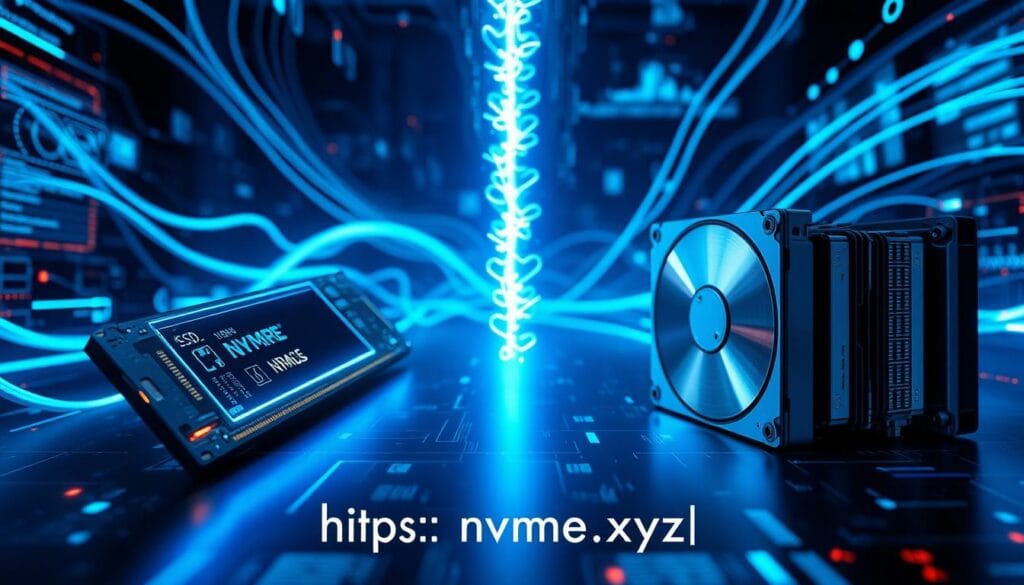In the last two years, the world has produced an astonishing 90% of its data. This has made the storage needs for big data analytics huge. With data growing at a rate of 40% every year, companies are struggling to use their data fully. NVMe (Non-Volatile Memory Express) SSDs are key, providing fast, low-latency, and scalable storage for big data analytics.
Key Takeaways
- NVMe SSDs offer up to 70% faster performance for big data applications compared to traditional storage solutions.
- The estimated data production is set to reach 463 exabytes (EB) every day by 2025, underscoring the need for scalable and high-speed storage.
- NVMe SSDs from Phison can achieve sequential read and write speeds of up to 7.4 GB/s and 7.0 GB/s, respectively, enabling faster data processing.
- Phison’s SSD solutions allow for machine learning training and control sets to scale up to 1 PB without affecting performance.
- Epoch times of machine learning algorithms can be up to 10x faster with Phison’s high-speed, low-latency storage controllers.
Storage Demands of Big Data Analytics in 2024
The global AI-powered storage market is set to grow a lot in the next few years. It’s expected to jump from USD 22.93 billion in 2023 to USD 28.71 billion in 2024. By 2033, it could reach USD 217.34 billion, growing at 25.22% each year. This growth is because companies want to get insights from big data.
North America is leading the way. The AI-powered storage market there is expected to grow from USD 8.25 billion in 2023 to USD 79.33 billion by 2033. This is a 25.40% growth rate from 2024 to 2033. The United States is also expected to see big growth, from USD 5.78 billion in 2023 to USD 55.93 billion by 2033. This reflects a 25.47% growth rate from 2024 to 2033.
Companies need storage solutions that are fast, low-latency, and can grow with their data. This has led to more use of direct-attached storage (DAS) and file-based storage. These are the top choices in the AI-powered storage market in 2023.
Cloud storage is also playing a big role in the growth of big data analytics. Cloud storage is expected to grow by 100 zettabytes, with 60% of data stored in the cloud. This move to cloud storage is because companies need solutions that are scalable, flexible, and accessible.
| Key Market Trends | Insights |
|---|---|
| AI Edge Devices Performance | AI edge devices less than 100 TOPS may require around 225 GB/s memory bandwidth, whereas those above 100 TOPS may need 451 GB/s. |
| Memory Technology Advancements | LPDDR5X offers a 50% increase in performance over LPDDR4, with up to 8.5 GT/s per pin, and LPDDR5 provides 20% better power efficiency than LPDDR4X. |
| AI Edge Processor Market Growth | The AI edge processor market is forecasted to grow to US$9.6 billion by 2030, according to Allied Market Research. |
As big data analytics demand grows, companies must update their storage plans. They need to meet the high performance and scalability needs of these workloads. By using the latest storage tech, like high-performance NVMe SSDs, companies can make the most of their big data analytics. This will help them stay ahead in 2024 and beyond.

NVMe SSDs vs Traditional Storage for Big Data
Speed and performance are key in big data analytics. NVMe SSDs are much faster than traditional hard disk drives (HDDs) and SATA SSDs. They offer quick data processing and low latency, essential for big data workloads.
NVMe SSDs, like PCIe 4.0 models, can transfer data at speeds up to 7,000 MB/s. SATA SSDs are much slower. NVMe SSDs also handle more random read and write IOPS than SATA SSDs. This means they can process more data at once, reducing wait times.
NVMe technology is now more affordable and reliable for businesses. It’s used in data centers for databases and analytics, where it’s needed for quick data handling. Gamers also choose NVMe SSDs for their fast performance and quick access to data. Cloud providers see NVMe SSDs as the best for fast app access and data storage.
| Storage Type | Sequential Read (MB/s) | Sequential Write (MB/s) | Random Read (IOPS) | Random Write (IOPS) |
|---|---|---|---|---|
| NVMe SSD | 7,450 | 6,900 | 1,100,000 | 200,000 |
| SATA SSD | 550 | 520 | 98,000 | 30,000 |
SATA SSDs are cheaper per gigabyte than NVMe SSDs. They’re faster than HDDs but slower than NVMe SSDs. SATA SSDs are easy to upgrade and work well in many systems.
In summary, NVMe SSDs are better for big data due to their speed and cost. SATA SSDs are good for other uses. The right choice depends on your specific needs.

Accelerating Data Processing with NVMe Storage
NVMe (Non-Volatile Memory Express) SSDs have changed how we handle data, mainly in big data analytics. These high-speed storage options offer unmatched bandwidth and quick access times. They are key for companies wanting to speed up their data handling.
NVMe SSDs, like Microchip’s Flashtec NVMe 5016 controller, can read data over 14 GB per second. This boosts the use of computer power under heavy loads. The controller also handles random reads at 3.5 million IOs per second and over 2.5 GB of data per watt. This meets the power needs of data centers.
The NVMe protocol’s parallel nature is a big plus. It lets companies process data up to 10 times faster than old storage. NVMe devices can handle up to 64,000 requests at once. This is vital for today’s big data tasks.
NVMe SSDs also use advanced Flash memory and strong Error Correction Code (ECC) for data safety. They come with security features like Secure Boot and encryption. This makes them perfect for critical big data analytics tasks.
As the need for quick insights and data-driven choices grows, more companies are choosing NVMe storage. It lets them fully use their big data. With NVMe’s high speed, low latency, and parallelism, businesses can quickly process their data. This helps them get insights fast from their large data sets.
| Feature | Benefit |
|---|---|
| High Bandwidth | Enables maximum performance for demanding workloads, with NVIDIA’s DGX nodes able to ingest up to 48 GB/s of bandwidth. |
| Low Latency | Excelero’s NVMesh software provides low latency of 5µs, allowing for high IOPS levels and distributed, linearly scalable architecture. |
| Parallelism | NVMe devices have 64,000 queues, enabling them to serve as many as 64,000 parallel requests for data, critical for modern, data-intensive workloads. |
| Data Integrity | NVMe SSDs support advanced Flash memory technologies and strong Error Correction Code (ECC) capabilities to ensure data integrity and reliability. |
By using NVMe storage, companies can reach new heights in performance, scalability, and efficiency in big data analytics. This helps them make better, data-driven choices that lead to success.

Scalability and Performance Benefits of NVMe in Big Data Environments
In big data analytics, storage solution scalability and performance are key. NVMe SSDs stand out, allowing storage capacity to grow without tying up compute resources. This lets organizations handle more data without running into infrastructure limits.
NVMe’s linear performance scaling is a major plus. Adding more capacity boosts the system’s performance, avoiding the slowdowns of older storage. It also makes the system more responsive by handling commands more efficiently.
NVMe’s benefits go beyond just scaling and speed. It’s great for AI, ML, and data analytics because of its low latency and high throughput. It’s also good for virtualized environments, where many virtual machines run at once.
Though NVMe drives might cost more upfront, they save money in the long run. They use less power and cooling, making infrastructure more efficient.

As big data analytics grows, NVMe’s scalability and performance will be more important. Using NVMe technology helps organizations prepare for the future. They can handle more data and demanding tasks without issues.
Choosing the Right NVMe SSD for Big Data Analytics
When picking the best NVMe SSD for big data, several key factors come into play. These include sequential and random read/write speeds, how much storage you need, and how secure the data is. High-end NVMe SSDs like the Samsung PM9A3 and PM893 are top choices for big data needs. They offer fast performance, lots of storage, and strong data protection. For those using desktops or laptops, the Samsung 990 PRO NVMe SSD is great for smaller data analytics and AI/ML tasks.
Performance is key when picking an NVMe SSD for big data. Look for drives that can fill the PCIe 4.0 bus and have low latency and quality of service (QoS). QLC technology, with four bits per cell, boosts data capacity. This makes QLC SSDs a cost-effective choice for tasks like AI, ML, and big data analytics.
| Metric | HDD | SATA SSD | NVMe SSD |
|---|---|---|---|
| Speed | Slower | Faster | Fastest |
| Reliability | Lower | Higher | Highest |
| Power Consumption | Higher | Lower | Lowest |
Capacity is also critical when choosing an NVMe SSD for big data. QLC NAND SSDs can hold up to 61.44TB. This makes them perfect for large datasets. For example, the Solidigm D5-5336 SSDs can store 2PB in just 1U of rack space. This is 18x less space than 20TB HDDs.
Data security is essential when picking an NVMe SSD for big data. Enterprise-grade solutions like the Samsung PM9A3 and PM893 have strong data protection. By focusing on performance, capacity, and security, organizations can find the right NVMe SSD for their big data analytics needs.

Optimizing Storage Configurations for Big Data Workloads
Enterprises use a tiered storage approach to manage big data analytics. They have a fast NVMe tier for active data and a larger, cheaper tier for less used data. Samsung’s Disaggregated Storage System (DSS) makes storage more efficient by turning hardware into a networked pool.
Digital business growth will lead to more unstructured data in the next few years, says Gartner. AI, ML, and big data projects can grow to petabytes. Projects with images and videos need large single files. To handle this, organizations use network-attached storage (NAS) for its scalability and flexibility.
When setting up storage for big data, consider the data and processing needs. AI projects like surveillance and facial recognition need petabyte storage. But, business systems data might only need a few hundred megabytes. Tailoring storage to the workload ensures optimal performance and efficiency.
The storage setup must also meet performance needs. Machine learning and dense neural networks need high throughput and low latency. The learning phase of AI and ML projects is the most data-intensive. To meet these needs, use NVMe and flash-based storage for better performance and scalability.

By optimizing storage for big data, enterprises can support their data management and analytics. This approach helps unlock big data’s full value. It drives insights for strategic decision-making and business growth.
Case Studies: NVMe SSDs in Big Data Analytics
Real-world examples show how NVMe SSDs boost big data analytics. Switching to NVMe solutions leads to better performance, lower costs, and better business results. These examples show how NVMe storage can help companies get the most out of their big data efforts and stay ahead in their fields.
Samsung’s PM9A3 NVMe SSD is great for AI tasks, with speeds of up to 6,900/4,100 MB/s and 1.1 million/200,000 IOPS. The Samsung PM893 SATA SSD is also good for AI/ML, with speeds of up to 550/520 MB/s and 98,000/30,000 IOPS.
Ocient’s all-NVMe software cuts down on network bottlenecks and old disk energy use. This reduces costs, space, and energy use by up to 90% for tough workloads. Ocient’s Megalane™ technology uses parallel processing and high queue depths for fast query performance.
GPU servers are key for scientific breakthroughs, helping researchers handle big data and complex algorithms. Servers with NVIDIA Tesla/Quadro/RTX Series can process data much faster than CPUs, making them vital for data science and analytics.
| Solution | Performance Improvements | Cost Savings | Business Outcomes |
|---|---|---|---|
| Samsung PM9A3 NVMe SSD | 6,900/4,100 MB/s sequential read/write, 1.1 million/200,000 IOPS random read/write | N/A | Optimized for AI workloads |
| Samsung PM893 SATA SSD | Up to 550/520 MB/s read/write, 98,000/30,000 IOPS random read/write | N/A | Suitable for AI/ML requirements |
| Ocient’s all-NVMe software architecture | N/A | Up to 90% reduction in cost, footprint, and energy consumption | Eliminated network bottlenecks and less energy-efficient spinning disks |
| NVIDIA GPU servers | Dramatically faster data processing compared to CPUs | N/A | Catalysts for scientific discovery, accelerating data science and analytics |
These examples show how NVMe SSDs and GPU servers are changing big data analytics. They offer better performance, cost savings, and business results for companies in many industries.

The Future of Big Data Storage: NVMe and Emerging Technologies
As big data analytics needs grow, NVMe SSDs will team up with new tech. Persistent memory, computational storage, and storage class memory are on the horizon. They promise lower latency, more bandwidth, and better processing near the data. This combo will boost performance, efficiency, and scalability in big data analytics.
NVMe SSDs are already a hit in big data, beating old storage in speed and bandwidth. They scale well, letting data centers grow storage without losing speed, key for fast-growing data. Plus, NVMe’s design for multitasking makes it great for tasks like virtualization and data analytics.
But, the future of big data storage is more than just NVMe. New tech like persistent memory, computational storage, and storage class memory are set to change data handling. Persistent memory is faster than NVMe, and computational storage moves processing tasks from the CPU. Storage class memory is a middle ground between memory and storage, making big data access more efficient.
As data volumes, speeds, and types keep rising, combining NVMe with these new techs is key. This mix will help companies build top-notch storage for data analytics. From quick decisions to AI and machine learning, the future of big data storage is bright, thanks to NVMe and new tech.

Conclusion
NVMe SSDs are key in the world of big data analytics. They offer top-notch performance, low latency, and growable storage. This makes them essential for companies aiming to get the most out of their big data projects.
NVMe-oF technology is growing fast and is used in many fields. This shows how important NVMe SSDs are for handling big data tasks. As more companies need to analyze big data, the need for fast storage will keep growing. This will push for more improvements and wider use of NVMe storage.
The future looks bright for NVMe SSDs with new storage tech on the horizon. This will make NVMe SSDs even better for big data work. Companies can stay ahead by choosing the right NVMe SSDs and using their speed and scalability. This way, they can succeed in the fast-changing world of big data analytics.
